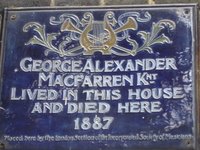Keeping that in mind, who are these guys?

I haven’t the foggiest! I had to look them up and I will share my information with you so when you pass by you can be well-informed.
William Strang (1859-1921) was a Scottish painter and engraver. This is where the English Heritage system breaks down for me. A candidate has to be considered eminent by a majority of members of their own profession. How many engravers could there have been at this time? He was born in Dumbarton Scotland (sound familiar Bay Area readers?) Apparently best known for his etchings, some well known men sat for portraits by Mr. Strang including Rudyard Kipling, Robert Louis Stevenson and Thomas Hardy. He is also well known for his illustrations of Sinbad the Sailor, Paradise Lost and Pilgrim’s Progress. He lived here in our house until he died.

The second blue plaque is something of a mystery to me. I can’t find out any information about the organization that honored Sir George Alexander Macfarren (1813-1887). It is not an official English Heritage plaque because it is not round but obviously was designed to closely resemble the official plaques so as to confuse the well-informed passerby. In almost every entry about him, he is referred to as a prolific composer, not great, not good, he just did a lot. He apparently is best known among other composers for his lectures and writings on music theory. Macfarren became blind in 1860 and continued his career lecturing. He was knighted in the late 1870s and died “suddenly”, again in our house!!! The interesting tidbit we found out is that Sir Macfarren and Snake share the same birthday, 180 years apart. Coincidence? Maybe. Weird, definitely.
Okay, so the other day I am putting out our rubbish (another English word!) in the bins (!) and a man comes over to me. He is carrying his London map so I am clued in that he is a tourist. He is reading the plaques on the wall and asks me about the men. I tell him what I know and he scoffs at me, “I have never heard of them”. Well, I pointed out to him that these men had died quite some time ago. He asks me what you have to do to get a plaque and I explain the criteria, as I understand them. “Well” he says with a tone “ I have a friend who lives on this street and he is very famous, and you would know him if I told you who he is and he doesn’t have a plaque”. Like I am supposed to defend the plaques on my house as if I had some hand in deciding that they should be there! But in a way I am feeling very defensive of my guys. Who is this man to put down my historic dead guys? What has he done?? So I asked him “Is your friend dead or at least 100 years old?” He shakes his head negatively. “No? Well then. That would be it then, wouldn’t it?” I turned on my heel and went back in my flat.
Maybe they are boring, unknown to most people, old dead guys BUT they are MY boring, unknown to most people, old dead guys!
1 comment:
“No? Well then. That would be it then, wouldn’t it?”
We've lost her folks. With a response like that she's become a Brit. All I can say is that anyone driving in Lafayette this summer should watch out for an SUV driving on the left. I hope Kiki and Snake can swim on a hearty breakfast of bangers and mash.
Post a Comment